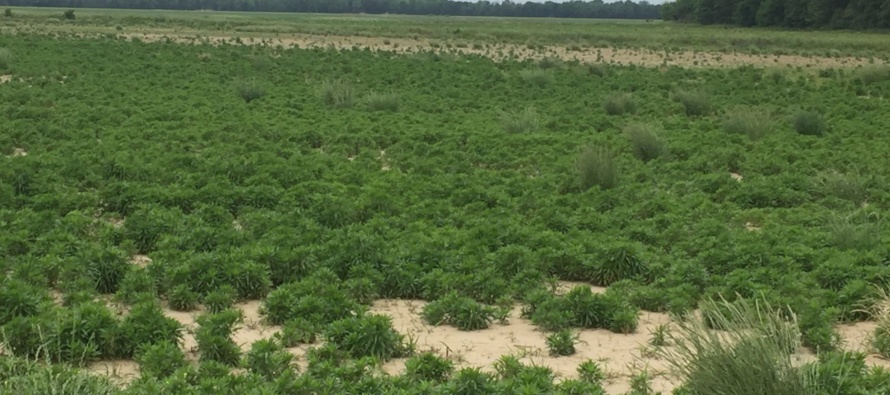Preplant Intervals for 2,4-D and Dicamba Applied as Burdown in Mississippi

Related Articles
- 2010 Soybean And Corn Variety Trial Data 3
- Rice Variety Trial Results For 2010, Plus Rice Research Report 0
- Fertilizing Cotton with Poultry Litter 5
Latest Tweets
 The new Enlist Weed Control System from Dow Agrosciences and the Roundup Ready Xtend Crop System from Monsanto have garnered much attention this winter as both of these technologies will be prominent in Mississippi in 2017. However, older formulations of 2,4-D and dicamba are still foundational herbicides during burndown, and the time for using these herbicides for burndown in Mississippi is growing short. Observing the preplant intervals for 2,4-D and dicamba prior to planting is important.
The new Enlist Weed Control System from Dow Agrosciences and the Roundup Ready Xtend Crop System from Monsanto have garnered much attention this winter as both of these technologies will be prominent in Mississippi in 2017. However, older formulations of 2,4-D and dicamba are still foundational herbicides during burndown, and the time for using these herbicides for burndown in Mississippi is growing short. Observing the preplant intervals for 2,4-D and dicamba prior to planting is important.
Labels for different formulations of dicamba (Clarity, Banvel, etc.) are fairly consistent regarding preplant intervals. Dicamba may be applied to fields that will be planted to corn at any time until planting. Once corn is planted, dicamba applications should be avoided until after corn emergence. In fields that will be planted to soybean, the dicamba preplant interval is strict. The Clarity label states, “following application of Clarity and a minimum accumulation of one inch of rainfall or overhead irrigation, a waiting interval of 14 days is required for 8 fluid ounces per acre, and 28 days is required for 16 ounces per acre. These intervals must be observed or crop injury will occur.” In fields to be planted to cotton, at least one inch of rainfall and a 21-day preplant interval is required The key point is the rainfall total is required before the clock begins between dicamba application and soybean or cotton planting. Grain sorghum and rice may be planted 15 days following dicamba.
A multitude of 2,4-D formulations are labeled in Mississippi. These can be formulated as acid, amine, or ester formulations. Even though all 2,4-D labels do not contain the same wording, there is continuity concerning preplant intervals among the labels for 2,4-D products commonly sold this time of year by the retailers in Mississippi. The preplant intervals in Table 1 are for ester formulations of 2,4-D.
| Table 1. Plantback restrictions for 2,4-D ester formulations applied in burndown applications. | |||||||
| Herbicide | Distributor | Rate | Corn | Cotton | Grain sorghum | Rice | Soybean |
| lb ae/A | _________________ days before planting _________________ | ||||||
| Barrage HF | Helena Chemical Company | 0.5 | 7 | 30 | 29 | 30 | 7 |
| 1.0 | 14 | 30 | 29 | 30 | 15 | ||
| Havoc LV-Six | Jimmy Sanders | 0.5 | 7 | 30 | 29 | 30 | 7 |
| 1.0 | 14 | 30 | 29 | 30 | 15 | ||
| Salvo | Crop Production Services | 0.5 | 7 | 30 | 29 | 30 | 7 |
| 1.0 | 14 | 30 | 29 | 30 | 15 | ||
| Shredder LV4 | Green Point AG | 0.5 | 7 | 30 | 29 | 30 | 7 |
| 1.0 | 14 | 30 | 29 | 30 | 15 | ||
As a general rule, 2,4-D ester is more effective for control of some winter annual weed species including curly dock. Furthermore, ester formulations should be applied when day-time temperatures are <55 to 60 F. When day-time temperatures are consistently >55 to 60 F, then amine formulations should be utilized. If an ester formulation is utilized, the preplant interval for soybean is 7 days following 2,4-D ester at 0.5 lb ae/A and 15 days following 2,4-D ester at 1.0 lb ae/A. If an amine formulation is utilized, the preplant interval for soybean planting is 15 days following 2,4-D amine at 0.5 lb ae/A and 30 days following 2,4-D amine at 1.0 lb ae/A. Therefore, caution should be exercised when matching a 2,4-D formulation to the cropping scenario.
2,4-D labels can be frustrating to decipher. Use caution when making applications of auxin herbicides. Better to be safe and read the label of the product that is actually going into the sprayer than to be sorry and suffer consequences from herbicide drift or carryover. Keep in mind that any burndown application of glyphosate plus 2,4-D and/or dicamba will work slowly, even with the warmer weather. If burndown gets delayed and the field is ready to plant, consider changing the burndown to a paraquat-based application.




Let me tell You a sad story ! There are no comments yet, but You can be first one to comment this article.
Write a comment